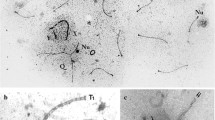Abstract
In the domestic pig (2n=38) two types of constitutive heterochromatin can be differentiated by fluorescence counterstaining techniques. All 24 biarmed autosomes and the X chromosome have chromomycin A3-positive centromeric C-bands, whereas all 12 acrocentric chromosomes exhibit DA-DAPI-positive centromeric heterochromatin. Fluorescence analysis of male pachytene nuclei revealed that the DA-DAPI-positive C-bands form one or two large chromocentres per cell, while the chromomycin A3-bright C-material is well scattered. Hence, the bivalents formed by the acrocentric chromosome pairs are centromerically associated, whilst the submetacentric bivalents are not. —Counce-Meyer spreading techniques were used to study the structure of synaptonemal complexes (SCs) both by light and electron microscopy. In general, the SCs of the domestic pig resemble those described for other mammals. The SC formed by the X and the Y may include up to 94.5% of the Y chromosome. In silver-stained microspreads each of the bivalents (nos. 8 and 10) bearing the nucleolus-organizer-regions (NORs) is connected to a pair of nucleoli, indicating that all four NORs are active during early meiotic stages. By contrast, in the majority of mitotic metaphases of phytohaemagglutinin-stimulated lymphocytes only one pair (no. 10) exhibited Ag-NOR staining. — The significance of the chromosome disposition in the pachytene nucleus is discussed with regard to heterochromatin composition and karyotype evolution.
Similar content being viewed by others
References
Alonso RA, Cantu JM (1982) A Robertsonian translocation in the domestic pig (Sus scrofa) 37, XX, −13, −17, t rob (13; 17). Ann Genet 25:50–52
Counce SJ, Meyer GF (1973) Differentiation of the synaptonemal complex and the kinetochore in Locusta spermatocytes studied by whole mount electron microscopy. Chromosoma 44:231–253
Czaker R, Mayr B (1980) Detection of nucleolus organizer regions (NOR) in the chromosomes of the domestic pig (Sus scrofa domestica L.). Experientia 36:1356–1357
Dover G (1982) Molecular drive: a cohesive model of species evolution. Nature 299:111–117
Dresser ME, Moses MJ (1980) Synaptonemal complex karyotyping in spermatocytes of the Chinese hamster (Cricetulus griseus). IV. Light and electron microscopy of synapsis and nucleolar development by silver staining. Chromosoma 76:1–22
Driscoll DJ, Palmer CG, Melman A (1979) Nonhomologous associations of C-heterochromatin at human male meiotic prophase. Cytogenet Cell Genet 23:23–32
Howell WM, Black DA (1980) Controlled silver staining of nucleolus organizer regions with a protective colloidal developer: a 1-step method. Experientia 36:1014–1015
Hsu TC, Cooper JEK, Mace ML Jr, Brinkley BR (1971) Arrangement of centromeres in mouse cells. Chromosoma 34:73–87
Kodama Y, Yoshida MC, Sasaki M (1980) An improved silver staining technique for nucleolus organizer regions by using nylon cloth. Jpn J Hum Genet 25:229–233
Kurnit DM, Brown FL, Maio JJ (1978) Mammalian repetitive DNA sequences in a stable Robertsonian system. Characterization, in situ hybridizations, and cross-species hybridizations of repetitive DNAs in calf, sheep, and goat chromosomes. Cytogenet Cell Genet 21:145–167
Lin CC, Biederman BM, Jamro HK, Hawthorne AB, Church RB (1980) Porcine (Sus scrofa domestica) chromosome identification and suggested nomenclature. Can J Genet Cytol 22:103–116
Lin CC, Joyce E, Biederman BM, Gerhart S (1982) The constitutive heterochromatin of porcine chromosomes. J Hered 73:231–233
Mayr B, Schnedl W, Schleger W (1979) Paarungsverhalten der meiotischen Chromosomen beim Rind. Z Tierzücht Züchtungsbiol 95:112–117
Mayr B, Schweizer D, Geber G (1984) NOR activity, heterochromatin differentiation, and the Robertsonian polymorphism in Sus scrofa L. J Hered 75:79–80
Moses JM (1977a) Synaptonemal complex karyotyping in spermatocytes of the Chinese hamster (Cricetulus griseus). I. Morphology of the autosomal complement in spread preparations. Chromosoma 60:99–125
Moses JM (1977b) Synaptonemal complex karyotyping in spermatocytes of the Chinese hamster (Cricetulus griseus). II. Morphology of the XY pair in spread preparations. Chromosoma 60:127–137
Ruzicka F (1974) Effect of G-banding techniques on the ultrastructure of human chromosomes. Hum Genet 22:119–126
Schnedl W, Abraham R, Förster M, Schweizer D (1981) Differential fluorescent staining of porcine heterochromatin by chromomycin A3/distamycin A/DAPI and D287/170. Cytogenet Cell Genet 31:249–253
Schwarzacher HG, Wachtler F (1983) Nucleolus organizer regions and nucleoli. Hum Genet 63:89–99
Schweizer D (1980) Simultaneous fluorescent staining of R-bands and specific heterochromatic regions (DA-DAPI bands) in human chromosomes. Cytogent Cell Genet 27:190–193
Schweizer D (1981) Counterstain-enhanced chromosome banding. Hum Genet 57:1–14
Schweizer D, Mendelak M, White MJD, Contreras N (1983) Cytogenetics of the parthenogenetic grasshopper Warramaba virgo and its bisexual relatives. X. Patterns of fluorescent banding. Chromosoma 88:227–236
Sims SH, Macgregor HC, Pellatt PS, Horner HA (1984) Chromosome 1 in crested and marbled newts (Triturus). An extraordinary case of heteromorphism and independent chromosome evolution. Chromosoma 89:169–185
Solari AJ (1980) Synaptonemal complex and associated structures in microspread human spermatocytes. Chromosoma 81:315–337
Thomas JB, Kaltsikes PJ (1976) A bouquet-like attachment plate for telomeres in leptotene of rye revealed by heterochromatin staining. Heredity 36:155–162
Tres LL (1977) Extensive pairing of the XY bivalent in mouse spermatocytes as visualized by whole-mount electron microscopy. J Cell Sci 25:1–15
Author information
Authors and Affiliations
Additional information
This paper is dedicated to Prof. Hans Bauer on the occasion of his 80th birthday
Rights and permissions
About this article
Cite this article
Schwarzacher, T., Mayr, B. & Schweizer, D. Heterochromatin and nucleolus-organizer-region behaviour at male pachytene of Sus scrofa domestica . Chromosoma 91, 12–19 (1984). https://doi.org/10.1007/BF00286480
Received:
Issue Date:
DOI: https://doi.org/10.1007/BF00286480



